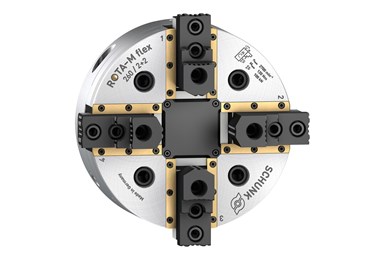Schunk Rota-M Flex Chuck Jaw Offers Flexible Clamping Capabilities
Appears in Print as: 'Chuck Jaw Offers Flexible Clamping Capabilities'
Chuck jaw has a very long compensation stroke, giving it increased flexibility for clampable workpiece geometries and a wide variety of applications.
Edited by Angela Osborne

Sealed guideways ensure process safety of the centrically compensating Schunk Rota-M flex 2+2 chuck.
Schunk’s Rota-M flex 2+2 is a low-maintenance, 2+2 chuck jaw specially designed to maximize clamping flexibility on mill/turn machines. The compensating mechanism provides a very long compensation stroke. Depending on the size, it amounts to 5.1 mm up to 10 mm per jaw. This means a single jaw offers the flexibility to clamp a wide variety of workpiece geometries.
Special seals on the guideways prevent grease from washing out under coolant pressure and gradual loss of clamping force. That company says that, even in the case of low clamping forces, precise functioning of the chuck is ensured. At the same time, the sealings protect the chuck body against chips and dirt, meaning process safety increases and maintenance intervals are extended. For increased safety, the Schunk Rota-M flex 2+2 clamping is done in a self-locking manner, and the clamping condition is signaled via indicating pins. The standard chuck sizes 260 to 1200 achieve jaw strokes from 9.5 to 17.8 mm and high clamping forces from 100 to 180 kN.
With the 800 size, users benefit from the weight-reduced design. The chuck face is equipped with grooves and fixed stops enable the chuck to also be used as a vise. Also, the large sizes are designed for use on vertical lathes. The Schunk Rota-M flex 2+2 is equipped with a flexible serration (1.5 mm × 60 degrees or 1/16" × 90 degrees) so that the user can fully exploit the benefits of a large range of standard chuck jaws.
RELATED CONTENT
-
Skiving Long, Slender Parts with Tight Tolerances
Here's a look at one of the oldest and most efficient methods of screw machine production for parts that are long and slender, with close-diameter tolerances and finishes, or parts that require truly spherical radii.
-
Calculating Surface Footage and RPM for Optimum Tool Life
Tech Brief: Calculating Surface Footage and RPM for Optimum Tool Life
-
4 Strategies for Managing Chip Control
Having strategies in place for managing chips is an important part of protecting the production process, from tool life to product quality.



